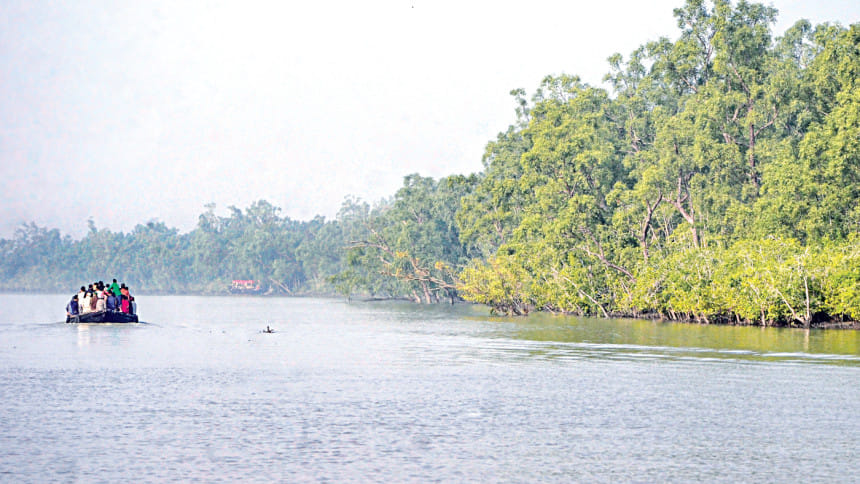The Sundarbans: Calls grow louder for eco-friendly tourism

As soon as winter begins, the Sundarbans sees an influx of tourists who come to enjoy the tranquil and exotic atmosphere of the world's largest mangrove forest.
This winter is no different as domestic travellers are flocking to places officially open to the public, including Karamjal, a popular tourist destination near the south-western port town Mongla.
However, this has raised calls for facilitating tourism in a way that cares for nature and protects biodiversity in the Sundarbans instead of affecting its natural harmony.
The flow of tourists, mostly inbound, has created income opportunities for tour operators, hotels, resorts and other service providers.
Nearly 43,000 people visited the Sundarbans in the first half (July-December) of fiscal year (FY) 2021-22, according to the forest department.
Md Sharif Hasan Limon, professor of forestry and wood technology discipline at Khulna University, said the current nature of public movement in the region was mainly mass tourism and does not maintain eco-friendly measures.
"Such tourism destroys the ecology. We have to ensure that tourism does not affect the natural environment," he said.
The forest, rich in flora and fauna, registered its highest number of visitors at 2.21 lakh in FY 2017-18.
Since then, the number of tourists declined for multiple factors, including security concerns, restrictions by the forest department, and lack of accommodation and other facilities near the forest, which is highly cherished for its Bengal Tigers and Spotted Deer.
Limon went on to say that forest authorities should control the flow of tourists.
Restrictions should be imposed this time of year as the breeding season for tigers is from November to January, he said.
"So, it is necessary to have a control on places where tigers move during this period," he added.
The flow of tourists declined to 151,320 in FY 2020-21, the lowest in five years, owing to the ongoing coronavirus pandemic, showed data from the forest department.
Not only the forest department, but all stakeholders should come forward to protect the natural habitat of the Sundarbans, which was declared a UNESCO World Heritage Site in 1997.
"Everyone should be aware to maintain the natural habitat and protect the mangrove forest," he said.
Located in the country's southwest coastal region, the Sundarbans consists of about 200 islands, separated by about 400 interconnected tidal rivers, creeks and canals, according to Banglapedia.
Within the forest habitats, there are about 50 species of mammals, 320 species of inland and migratory birds, 50 species of reptiles, eight species of amphibians, and 400 species of fish, it said.
Professor Anwarul Qadir, executive director of the Sundarbans Academy, suggested regulated tourism.
"We have to work on the whole Sundarbans in order to protect it," he said.
"The extraction of all kinds of resources from the forest, including fish and crabs, needs to be stopped as catching these creatures from the forest area is upsetting the natural balance," Qadir added.
With this backdrop, ecotourism needs to be developed to cope with the growing pressure from tourists.
Nazmul Alam David, general secretary of the Tour Operators Association of Sundarbans, a Khulna based organisation, said nearly 80 operators facilitate tours centring the Sundarbans, generating several crores of taka in business.
The fall in visitors resulting from restrictions imposed by the forest department and for the Covid-19 pandemic affected the incomes of tour operators that offer various packages, including night stays and visits to Katka, Dublar Char and Hiran Point, which are popular spots along the coast of the Bay of Bengal.
Tourists can also visit the Harbaria, Kachikhali and Kalagachhia areas of the Sundarbans.
"We mainly get domestic and foreign tourists for three or four months each year but somehow it is being restricted in different ways by the forest department," he added.
Ecotourism is a very tough concept to adopt in Bangladesh as it is a densely populated country but if the people are sincere, it could happen.
In the name of ecotourism, the forest department is practicing mass tourism. Without any consultation from tour operators, local leaders or other stakeholders, the forest department is taking numerous projects.
"So, the forest department actually needs to be more pragmatic to introduce ecotourism after consultation with experts," David said.
Mihir Kumar Doe, conservator of forests of the Khulna Circle of the forest department, said the department has been implementing a Tk 24.95 crore project to facilitate eco-friendly tourism at the Sundarbans since January 2020.
The project has been taken in light of eco-friendly tourism policies, he added.
Under the project, various facilities such as seven watchtowers and foot rails for tourists to enter the forest would be constructed.

 For all latest news, follow The Daily Star's Google News channel.
For all latest news, follow The Daily Star's Google News channel. 



Comments